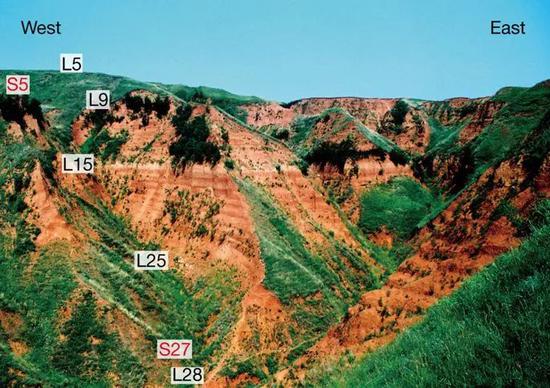Evidence for earliest known presence of hominins discovered in China

The landscape and loess-paleosol at the Shangchen site in Lantian County, Shaanxi Province (NATURE)
The stone tools unearthed in a newly discovered Paleolithic site in China appear to challenge the traditional timeline of human migration out of Africa.
Ancient humans appeared and lived in the Loess Plateau of China about 2.12 million years ago, according to the research paper recently published in the journal Nature by a research team led by the Guangzhou Institute of Geochemistry at the Chinese Academy of Sciences (CAS).
The stone tools were unearthed from Shangchen Village in Yushan Town, Lantian County, Shaanxi Province. The site is near Gongwangling, where the Lantian Man was discovered.
Previously, the earliest appearance of hominins outside Africa had been dated to 1.85 million years ago. However, the stone tools found in Shangchen indicate that humans may have appeared in Eastern Asia as early as 2.12 million years ago. This new discovery is of great significance for the study of early human origin and migration.
The Shangchen site contains 17 layers that extend from paleosol S15 that dated to approximately 1.26 million years ago to loess L28 that dated to about 2.12 million years ago. Eighty-two flaked and 14 unmodified stones were found between S15 and L28 including cores, flakes, scrapers, notches, points and hammerstones, which were evidence for use of tools by ancient humans. The majority of the stones were unearthed from the 11 paleosol layers.
The paper’s lead author Zhu Zhaoyu said they carried out dating of loess-paleosol sequences mainly by magnetic methods. He said that the site had seen a sequence of cultural artifacts with good continuity. It is very rare to find such a multi-layered soil with stone tools from different periods buried at one site. This shows that human beings were recurring and repeatedly living in this place, but the continuity of inhabitation is still uncertain.
Based on the evidence, the loess-paleosol and Paleolithic cultural sequences of a region were first established. This also proves that the loess area is a good and natural test site for ancient human studies, and it is necessary to strengthen study of the loess-paleosol sequence and the evolution sequence of ancient human culture in the loess area, Zhu said.
From 2004, with Guangzhou Institute of Geochemistry taking the lead, more than 10 institutes carried out investigation and geological excavation work at Shangchen and discovered the site, including the Institute of Earth Environment, the Institute of Vertebrate Paleontology and Paleoanthropology, South China Sea Institute of Oceanology and the Institute of Geology and Geophysics at CAS, as well as the University of Exeter in the UK.
This groundbreaking research has expanded the internationally leading Chinese loess-paleosol sequence research, opening up new directions in hominins and ancient cultural studies, and will prompt people to re-examine the pattern of the early origin, migration and diffusion of ancient humans.
LU HANG is a correspondent with Chinese Social Sciences Today.
(edited by JIANG HONG)
